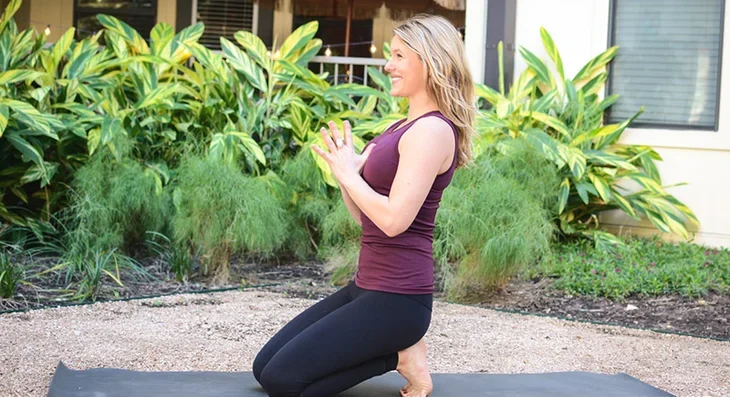Exercise Daily – In today’s fast-paced world, staying physically active is essential for a healthy lifestyle. However, engaging in physical activities can sometimes lead to injuries. Yoga, a centuries-old practice, has gained immense popularity for its spiritual and mental benefits and remarkable role in injury prevention and rehabilitation. This blog will explore how yoga can help individuals prevent injuries and recover effectively.
Yoga
1. What is Yoga?
Yoga is an ancient practice that originated in India. It involves a combination of physical postures, breathing exercises, and meditation techniques. The primary goal of yoga is to achieve physical and mental harmony.
2. Types of Yoga
There are various types of yoga, including Hatha, Vinyasa, Bikram, and Ashtanga. Each type focuses on different aspects of yoga, such as flexibility, strength, and meditation.

Yoga for Injury Prevention
Yoga is not just about striking picturesque poses or achieving mind-bending flexibility. It’s also a potent tool for injury prevention. This section will explore how yoga can help you stay injury-free and enjoy a healthier, more active life.
1. The Foundation: Balance and Awareness
One of the core tenets of yoga is balance. As you flow through poses, you learn to distribute your weight evenly, reducing the risk of falling or overstraining one side of your body. This balance extends beyond the mat, helping you avoid tripping on loose pavement or twisting your ankle on uneven ground.
Additionally, yoga fosters a heightened awareness of your body. You become more attuned to subtle signals, like muscle tightness or joint discomfort. This early warning system allows you to address issues before they escalate into full-blown injuries.
2. Flexibility: Your Secret Weapon
Flexible muscles and joints are less likely to suffer strains or tears. Yoga promotes flexibility by gently elongating muscles and increasing joint mobility. Poses like the forward bend and cobra stretch help to keep your muscles supple and responsive.
Greater flexibility also means you can move more freely, reducing the risk of sudden, jarring movements that can lead to injury.
3. Core Strength: A Shield for Your Back
Your core muscles, including your abdominals and lower back, play a vital role in stabilizing your spine. A strong core helps you maintain proper posture and supports your spine when lifting heavy objects or performing strenuous activities. Yoga poses like plank and boat pose are excellent for strengthening your core muscles.
4. Joint Health and Range of Motion
Maintaining healthy joints is crucial for injury prevention, especially as we age. Yoga helps keep your joints lubricated and improves their range of motion. Poses like the seated forward bend and the butterfly stretch gently work on your hip joints, helping to reduce the risk of hip injuries and increasing your mobility.
5. Body Alignment: Preventing Overuse Injuries
Poor body alignment can lead to overuse injuries, such as tendonitis or stress fractures. Yoga emphasizes proper alignment in each pose, ensuring that your body is in the optimal position to perform the movement safely. Over time, this attention to alignment becomes second nature and can protect you during various physical activities.
6. Stress Reduction: Less Tension, Fewer Injuries
Stress and tension can manifest physically, leading to muscle tightness and an increased risk of injury. Yoga’s deep breathing and relaxation techniques help alleviate stress, promoting a more relaxed body and mind. This reduced tension can translate into fewer injuries caused by muscle stiffness or clumsiness due to a distracted mind.

Yoga for Rehabilitation
Yoga isn’t just a practice for the physically fit or the flexible; it’s also a powerful ally in rehabilitation. Whether recovering from surgery, nursing an injury, or managing a chronic condition, yoga can play a vital role in your path to recovery and improved well-being.
1. Gentle, Gradual Healing
One of the key advantages of yoga in rehabilitation is its gentle and gradual approach. Unlike high-impact workouts that might exacerbate injuries, yoga offers a low-impact alternative that eases you back into physical activity. It respects your body’s limitations while gradually improving your strength and flexibility.
2. Enhanced Circulation and Reduced Inflammation
Yoga poses, combined with controlled breathing, enhance blood circulation. Improved blood flow means more oxygen and nutrients reach injured tissues, facilitating healing. Additionally, yoga helps reduce inflammation, a common culprit behind pain and slow recovery. Less inflammation means less discomfort and a faster healing process.
3. Pain Management
Chronic pain can be debilitating and significantly impact your quality of life. Yoga’s emphasis on mindfulness and relaxation techniques can serve as a valuable tool for managing and potentially alleviating chronic pain. By practicing meditation and deep breathing, you can learn to control your pain response better, potentially reducing the need for medication.
4. Restoring Range of Motion
After an injury or surgery, regaining your range of motion is often a primary goal. Yoga’s emphasis on gentle stretching can help you gradually regain flexibility in affected areas. Poses like the cat-cow stretch or child’s pose can be particularly beneficial.
5. Strengthening and Stability
Injuries often lead to muscle weakness and imbalances. Yoga combines strength-building poses, such as the warrior series, and stability-focused poses, like tree poses, which can help restore your body’s strength and balance. This, in turn, reduces the risk of re-injury.
6. Mental Resilience
Recovery can be mentally challenging, and frustration can be a significant hurdle. Yoga not only nurtures physical healing but also fosters mental resilience. By practicing mindfulness and remaining patient with your body’s progress, you can approach your rehabilitation positively.
7. Individualized Practice
Yoga is highly adaptable, making it suitable for individuals with various conditions and fitness levels. Whether recovering from surgery, managing chronic pain, or rehabilitating a sports injury, yoga can be tailored to your needs. Consult a qualified yoga instructor or a healthcare provider to design a practice that suits you best.
8. Building a Supportive Community
Yoga classes frequently offer a sense of community and mutual support. Sharing your rehabilitation journey with individuals encountering similar challenges can be motivating and inspiring. Being part of such a supportive yoga community can help you maintain your dedication to recovery.

The Science Behind Yoga’s Effectiveness
Yoga’s effectiveness in injury prevention and rehabilitation is not just anecdotal. Scientific research supports its benefits, and several key factors are at play.
1. Mind-Body Connection
Yoga encourages a strong mind-body connection. Practitioners learn to tune into their bodies, recognizing discomfort or tension before it leads to an injury. This heightened awareness can be a game-changer in preventing accidents.
2. Flexibility and Strength
Combining the flexibility and strength gained through yoga is crucial for injury prevention. A supple body, achieved through yoga, can more effectively adapt to unforeseen movements, ultimately lowering the risk of strains and sprains.
3. Stress Reduction
Stress is a recognized factor that can contribute to injuries and extend recovery periods. Yoga, with its calming impact on the nervous system, significantly lowers stress levels, fostering faster healing.
Incorporating Yoga into Your Routine
Incorporating yoga into your daily routine doesn’t require a complete lifestyle overhaul. You can take simple steps to reap the benefits of this ancient practice.
1. Consulting a Yoga Instructor
Consulting a qualified yoga instructor is advisable, especially if you’re new to yoga or have specific health concerns. They possess the expertise to customize a practice that suits your needs, guaranteeing safety and effectiveness in your yoga journey.
2. Home Practice Tips
Establishing a home yoga practice can be just as effective for those unable to attend classes. To begin, focus on beginner-friendly poses and, over time, progress in your practice. Additionally, there are online tutorials and apps available that can provide guidance along the way.
Conclusion
Yoga is not just a physical activity but a holistic practice that offers numerous benefits. Moreover, it includes injury prevention and effective rehabilitation. Its emphasis on flexibility, strength, balance, and mindfulness makes it an ideal choice for those seeking to stay injury-free or recover from injuries. By incorporating yoga into your fitness routine, you can achieve a healthier, more resilient body.
FAQs – The Role of Yoga in Injury Prevention and Rehabilitation
Q1. Can anyone practice yoga, or is it only for flexible people?
Yoga is for everyone, regardless of flexibility or fitness level. It can be adapted to suit individual needs and abilities.
Q2. How often should I practice yoga to prevent injuries?
Regular practice, even a few times a week, can significantly reduce the risk of injuries.
Q3. Are there specific yoga poses for injury rehabilitation?
Yes, there are yoga poses designed to aid in rehabilitating specific injuries. Consulting a yoga instructor or therapist is recommended for personalized guidance.
Q4. Can yoga replace medical treatment for injuries?
While yoga can be a valuable complementary therapy, it should not replace medical treatment. Always consult a healthcare professional for serious injuries.
Q5. Is yoga suitable for older adults looking to prevent injuries?
Absolutely! Yoga can improve balance and flexibility, making it an excellent choice for older adults seeking injury prevention.






